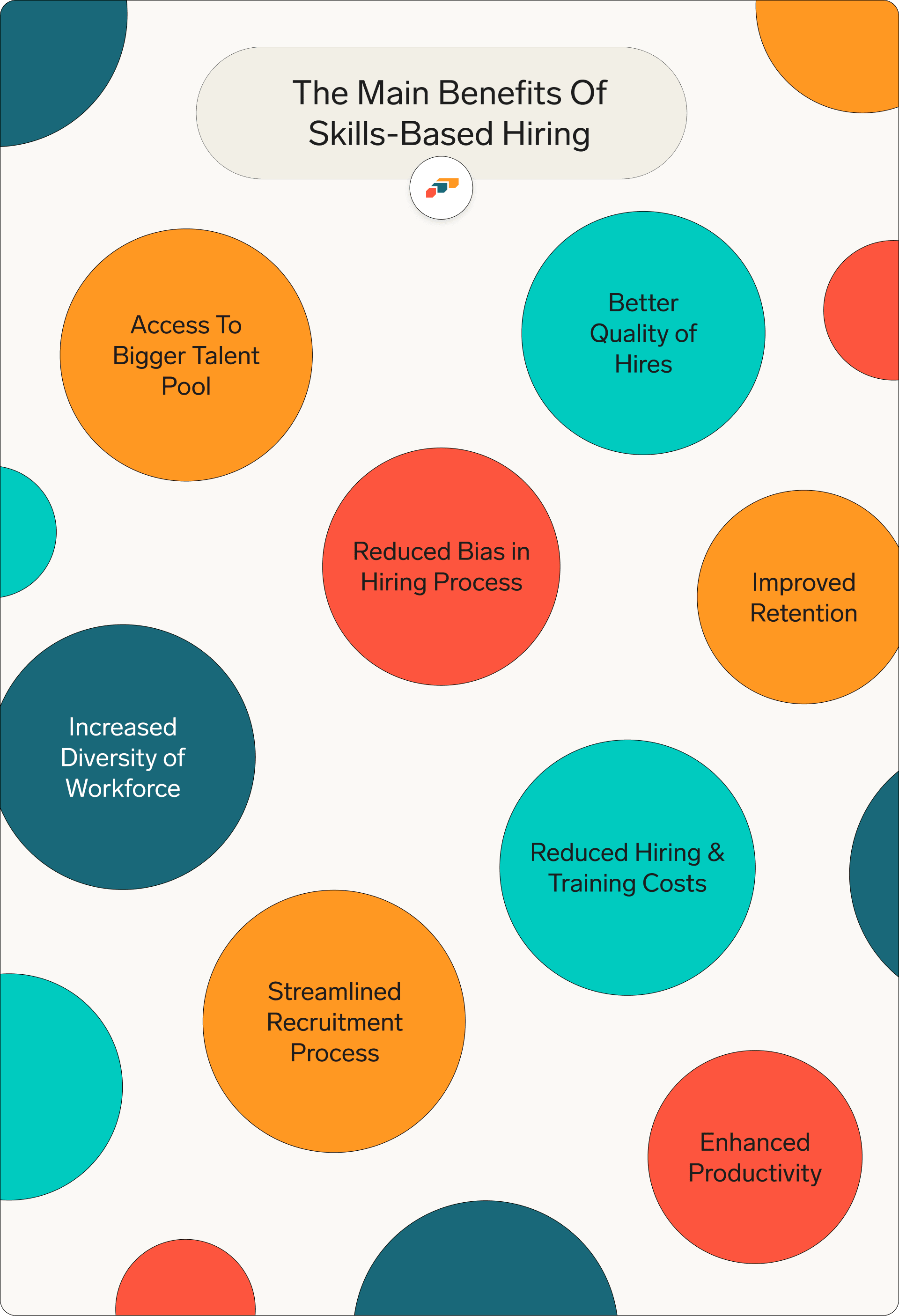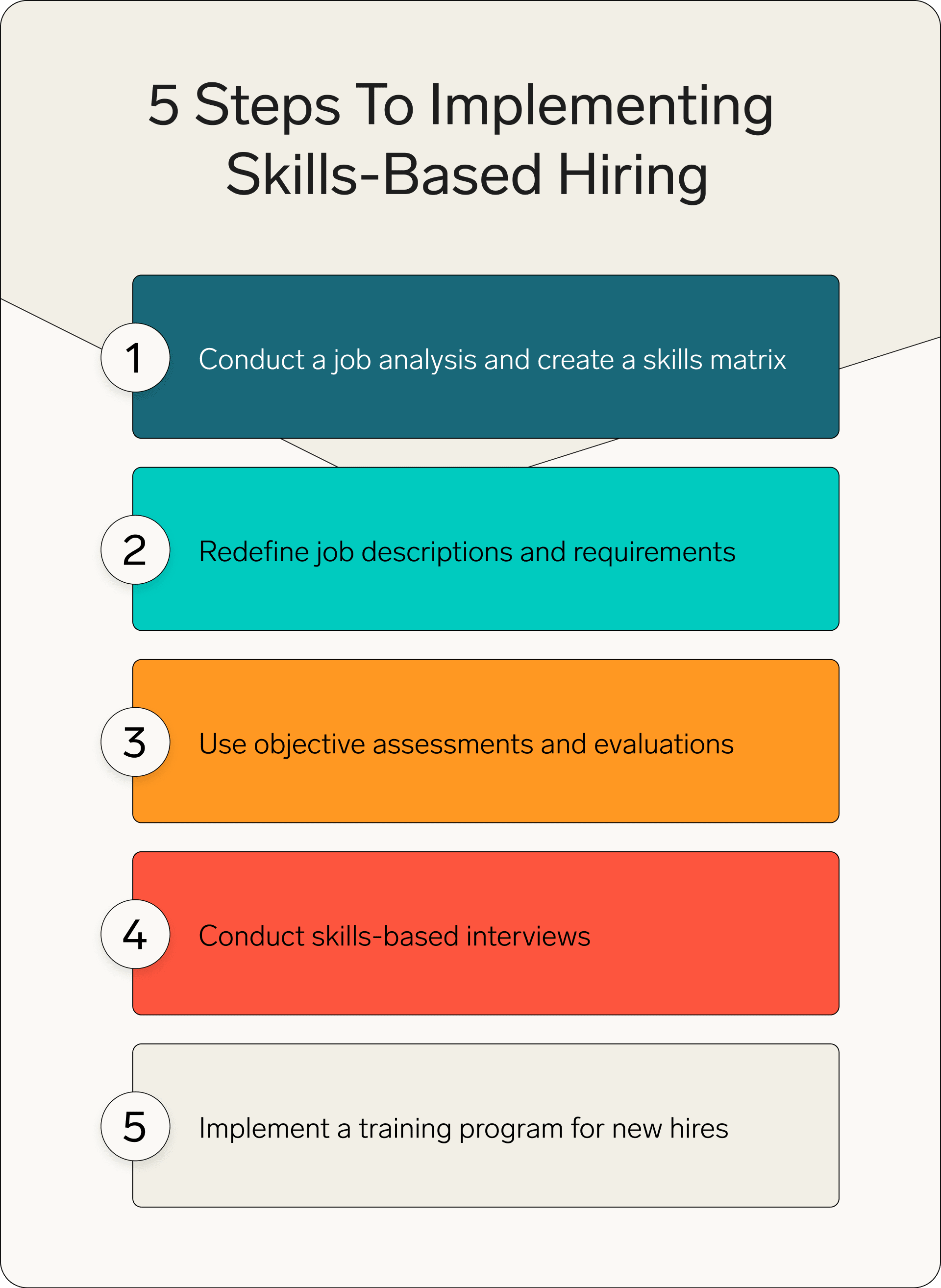100 Job Interview Statistics: First Impressions and Interview Processes
Master your next job interview with expert tips and statistics that will boost your confidence and impress potential employers.
- 16 Apr 2024
- Max 14 min read
The Number One HR Solution on Salesforce
Recruiting and hiring the right team members is a crucial part of any organization, especially in today's competitive labor market. Traditionally, HR professionals have relied on factors such as education and experience to select candidates, but this may not always be the best indicator of how successful a candidate will be in a role.
That's why skills-based hiring has been gaining traction lately. This approach looks at an individual's specific skills and qualifications that relate to the job and can increase diversity and retention, and improve overall job fit.
If you're looking for ways to make your hiring process even better, a skills-based approach could be the answer. We'll explain what it is and how to do it, share our top best practices, and help you tackle any potential obstacles along the way. With the right approach, it’s possible to create a team of experienced professionals that can take your business to the next level!
Skills-based hiring is a recruitment approach that looks beyond traditional qualities such as college degrees and job titles when making an assessment. Instead, employers look to the skills and abilities of potential candidates that relate to the specific job, evaluating them through tests, tasks, and interviews to see if they have what it takes.
The skills-based approach not only broadens the talent pool, but it enables organizations to recognize talented individuals who may not necessarily fit the traditional criteria but are just as capable of excelling in the role.
This hiring method is a major workplace trend, with top-tier corporations, such as Boeing, Walmart, and IBM joining initiatives that aim to promote skills-based practices, such as Rework America Alliance, the Business Roundtable's Multiple Pathways program, and the Tear the Paper Ceiling campaign.
Your company may already be utilizing the power of skills-based hiring, and you will have undoubtedly noticed other organizations using innovative approaches that emphasize a skills-based approach in their recruitment processes. Some of these methods include:
By crafting job postings that emphasize the skills and abilities that ideal candidates should possess, rather than solely focusing on traditional requirements like education, you can attract highly talented individuals who possess the right skill set for your organization.
These types of assessments mean candidates have the opportunity to answer questions and complete tasks related to their job, such as coding, writing, or data analysis. A recent survey conducted by the Society for Human Resource Management (SHRM) found that many employers are already embracing pre-employment assessments as a tool to evaluate job seekers and assess their knowledge, skills, and abilities. With over half of employers already taking advantage of this method, it's an increasingly popular option for those entering the workforce.
Recruiters present potential candidates with a project that is related to the role for which they are applying. This allows HR teams to measure how well the candidate will likely do in future tasks as well as get a sense of if they would be a good fit for the team.
A behavioral interview is a technique used by recruiters and hiring managers to assess a candidate's past behavior and experiences as an indicator of their future performance. Instead of hypothetical or theoretical questions, behavioral interviews focus on specific situations the candidate has encountered. It can be a great way to gain insight into how candidates approach and handle different scenarios. You can also evaluate their problem-solving skills and work style.
Candidates are invited to try out the job on a trial basis which allows companies to observe their ability to complete tasks and determine if they are a good fit for the position. This is common in the hospitality, food service, retail, and creative industries, although other industries may also use them occasionally.

Skills-based hiring can be a great way to find the best fit for your team. It involves assessing both hard and soft skills, so you can be sure that you’re looking at a well-rounded candidate who has the right qualities and qualifications. Hard skills are technical abilities such as coding or accounting, while soft skills refer to personality traits like communication, collaboration, and leadership.
According to TestGorilla's The State of Skills-Based Hiring 2022 report, 76% of employers use skills-based hiring to find new talent, and it's easy to see why it’s gaining traction. There are countless advantages to incorporating a skills-based approach into your organization's recruitment process, and the statistics are impressive. Let's look at some of the main benefits.
Nearly half of HR managers agree that filling entry-level jobs is the most challenging since candidates often lack four-year college degrees or relevant work experience. Therefore, it's worthwhile to consider alternatives to traditional linear hiring. By broadening the available talent pool and focusing on skillsets and strong potential for upskilling and reskilling, these positions can be filled easily.
According to the Bureau of Labor Statistics, 75 percent of available jobs require a bachelor’s degree, while only 40 percent of potential applicants have one. Skills-based hiring helps organizations find the best people for the job and is a great way to access a diverse talent pool, no matter a candidate’s background or degree.
When you hire based on skills and abilities, it increases the likelihood that your new team member fits into the position perfectly. Think of it like shopping at the superstore instead of the corner store – when there’s a wider selection of products you’re much more likely to find what you want. This in turn can lead to a greater fit between employee and company, leading to reduced turnover – eventually resulting in improved company success.
The advantages of having a diverse workplace are widely known. For example, McKinsey discovered that organizations in the top quartile for racial and ethnic diversity are 33 percent more likely to have financial returns above their respective national industry medians. Yet access to higher education for North Americans remains unequal, leading to disparities in degree attainment and employment opportunities. The pandemic worsened this situation and employers must embrace modern recruitment approaches or risk missing out on top talent.
By emphasizing skills-based hiring rather than degree requirements, companies can generate more inclusive career prospects, giving candidates from different backgrounds an even opportunity to demonstrate their capabilities.
Focusing on objective criteria means that skills-based hiring helps cultivate a sense of fairness during the recruitment process by removing any potential bias or discrimination associated with race, gender, or age. Moreover, it also offers great long-term benefits, allowing employers to identify and foster talent within their workforce, offering occupational advancement chances and expertise cultivation. This is advantageous for employees who may not have had access to higher education or face systemic obstructions to career progression and will help organizations increase employee engagement and retention.
Putting an emphasis on an individual's unique sets of skills and talents allows businesses to attract a diverse set of applicants from a variety of backgrounds.
Looking again at the research from TestGorilla, 91.1% of organizations saw an increase in diversity after implementing skills-based hiring. It’s clear that hiring based on skills and competencies can help create a flexible and accommodating workforce – and that’s beneficial for everyone. A more diverse team leads to bigger successes and ultimately, a more prosperous company.
Since employees are hired based on skills and abilities rather than certifications or previous job titles, skills-based hiring can increase employee retention, saving money and resources that would otherwise be spent on recruiting and training new employees.
McKinsey reports that hiring for an applicant's skills is the most reliable indicator of job performance, and employees without college degrees tend to stay in their roles 34% longer than those with degrees. When employees are hired for roles that align with their skills and abilities, they are likely to experience improved job satisfaction. This can lead to better job performance and higher levels of engagement and motivation.
Skills-based hiring can also help employees to identify and develop their skills and abilities, leading to more upskilling opportunities and a better return on investment for the organization. It also reduces the likelihood of employees leaving due to frustration with a lack of training or support.
A skills-first recruitment process also helps to set clear expectations about job responsibilities and performance, ensuring that employees understand the specific skills and abilities required for their role, which has a knock-on positive impact on retention.
When it comes to hiring skilled and motivated employees, the rewards can be immense. A skills-based approach to hiring means you can get the most from your team while increasing morale, reducing turnover, and creating an inclusive work environment where everyone feels appreciated.
Skills-based hiring can ensure your team is equipped with the knowledge and capabilities to do their job well. That can lead to better productivity and efficiency, plus cost savings and more revenue. When applicants have the skills and abilities needed to excel at a job, it means they'll quickly be able to jump in and contribute. This saves time and money on training programs and onboarding, meaning your team can hit the ground running and go further faster.
When it comes to talent acquisition, traditional methods can be slow and inefficient. Skill-based hiring is a great way to speed up the process. With this method, recruiters can ensure that they identify candidates who have the relevant qualifications as well as necessary on-the-job skills. This helps ensure the perfect fit for open positions is found the first time, as well as reducing time-to-hire. In fact, according to TestGorilla, 89.8% of organizations that implemented skills-based hiring practices saw a reduction in cost-to-hire and a 91.4% reduction in time-to-hire.

It’s clear that skills-based hiring helps create diverse and successful teams that can achieve amazing results, giving your organization the competitive edge it needs. So how can you implement this hiring approach in your organization? We've got you covered with these five easy steps that'll have you filling those open roles in no time:
First and foremost, get to know the role and identify any existing skills gaps by talking to the team and manager, as well as observing those already doing the job. With that information, you can create a skills matrix that outlines the key competencies needed. This will include a list of tasks, the required skills for each task, and an assessment of each person’s current skill level. With this in hand, it’ll be easier to find the right fit for the role when recruiting.
Once you've identified the key skills and expertise needed to do the job, you can revise the job description accordingly. With the information gathered from your job analysis research and skills matrix, you will be able to create a detailed job description. To attract diverse candidates, focus job descriptions on what skills and competencies are required rather than relying on qualifications like degrees or years of experience. Don't forget to post your job openings on multiple platforms to get the best candidates possible. LinkedIn and other professional recruitment sites are popular but don't overlook social media platforms like Instagram for finding unique and diverse talent. Remember, the more places you post, the more exposure you'll have! Plus, why not give the flair Career Portal builder a go? It'll help you create show-stopping careers pages that make a lasting impression.
At the heart of skill-based hiring is the use of objective assessments. This could be anything from skills tests, simulations, or work samples – allowing your team to really observe a candidate's individual skills and how they can perform job-related tasks. This will give you helpful insights into candidates' strengths or weaknesses – and can even spot potential areas for extra training or development over time.
When inviting applicants to complete job-related tasks or assessments, be mindful of their available time for research and completion. Additionally, it's worth understanding that some applicants may prefer to rely on their prior experience and work portfolio. To ensure you don’t miss out on great candidates, show flexibility regarding the duration of tasks and be open to negotiation.
During a skills-based interview, ask questions that give the candidate an opportunity to showcase their abilities. Try to focus on open-ended questions so you can get a full picture of the candidate’s experience and past successes. Don’t forget to ask follow-up questions as well, so you can draw out further details from their answers. You could also use scenario-based questions to help gauge the candidate’s problem-solving and critical-thinking skills. “Tell me about a time when you dealt with a difficult client” is a typical example of a scenario-based question. This will help you gain insight into how they might handle similar situations in the role.
The research you conducted at the start of the hiring process means you have already identified the necessary skills and competencies for the job, which will be a great help as you develop a training plan. Training should align with those original requirements, but also take into account the new hire's competencies. You can then tailor the training plan to focus on the areas where they may need help in order to excel in their new role.
You might choose to train new hires in different ways depending on their learning styles. Some examples include hands-on training, working with a mentor, or taking online classes. And be sure to check in regularly to see how they're doing and adjust training plans as needed. A little support can go a long way when it comes to helping your new hires succeed!
As is common when implementing organizational change, you may encounter some challenges among your team. If you're looking to introduce a skills-based hiring approach to your organization, it might be met with some resistance from hiring managers who are used to traditional methods. To ease the transition, we suggest educating everyone involved on the benefits of this approach and involving them in decision-making.
Also, remember that training is key. Providing HR staff and hiring managers with advice on how to carry out job analyses, create skills matrixes, and use objective assessments and evaluations will help them feel more confident.
Lastly, don't forget the resources available. Leveraging technology like applicant tracking systems can help streamline the entire process and make skills-based hiring more efficient.
Taking steps to overcome these common challenges will ensure your organization successfully adopts a skills-based hiring approach, allowing you to build a diverse and qualified workforce.

The flair Recruiting app is the perfect companion when implementing a skills-based hiring approach. It helps simplify your hiring process and source the best candidate for each job.
It's designed to support your HR team and make your recruitment process smooth and simple, from job advertising and screening resumes to evaluating applicants, right up to onboarding.
By streamlining the recruitment process, you can save valuable time and resources, allowing your team to truly engage with candidates and identify those who align perfectly with your organization. This goes beyond assessing skills alone and emphasizes the importance of finding individuals who also fit seamlessly into your company culture.
What's more, with the flair HR app you can help your new hires accomplish more and create clear career paths. Define goals and training paths, encourage feedback, and review performance – all in one place!
To stay ahead of the competition, savvy organizations are already making the switch to skills-based hiring. With the job market becoming ever more competitive, and technology advancing at a rapid rate, traditional college education is no longer a guaranteed indicator of success when hiring skilled workers. What companies need are talented individuals with well-rounded sets of skills that can quickly adapt to new technologies and changing business needs.
Not only does this approach bring numerous benefits including improved employee performance and productivity, reduced costs, and a competitive advantage, but it is also instrumental in creating a fairer playing field for all candidates. By reducing bias and promoting equity in the recruitment process, skills-based hiring can help you build a more diverse and resilient team. And diversity has been proven time and again to result in more successful and resilient organizations.
If you're ready to revolutionize your organization, then skills-based hiring can be key. So don't wait – join the future of work, and start building an unbeatable team with skills-based hiring today.
Equip your team for the future with flair, the all-in-one HR solution. Your success is our mission —book a demo now and see what flair can do for you!
Join flair’s newsletter to receive the latest tips & trends in the HR world.

